Exploring How Definition Affects the Performance and Aesthetic Caliber of LED Screens in Modern Display Techniques
Exploring How Definition Affects the Performance and Aesthetic Caliber of LED Screens in Modern Display Techniques
Blog Article
Light Emitting Diode walls are growing increasingly popular in different settings, from concerts and athletic competitions to corporate presentations and art exhibits. One of the key crucial factors that influence the performance and image clarity of these screens is resolution. Resolution refers to the quantity of picture elements that compose the image on the screen. Higher resolution indicates additional picture elements, which can result in clearer and crisper visuals. Grasping how image clarity affects LED walls can help users make knowledgeable choices about their screen requirements.
When discussing resolution, it is essential to consider picture spacing, which is the gap between the midpoint of one picture element to the midpoint of the next pixel. A smaller pixel pitch yields a greater image clarity, allowing for more detail in the images displayed. For instance, an LED screen with a picture pitch of 1.5mm will provide a clearer image than one with a picture spacing of 3mm. This is especially important in environments where viewers are close to the screen, such as in a compact location or a exhibition event booth. In these cases, a higher resolution can significantly improve the observing quality.
Another aspect of image clarity is its impact on color accuracy and brightness. LED screens with greater image clarity often have superior color reproduction, indicating that the hues shown are more vibrant and true to life. This is essential for uses like marketing, where the goal is to attract interest and convey a message effectively. Additionally, higher resolution displays can preserve luminosity levels even when seen from various perspectives. This go to this website is crucial in big venues where viewers may be positioned at different distances and angles from the display.
The functionality of LED walls is also influenced by resolution in terms of refresh rates and response durations. A greater image clarity screen can support quicker update frequencies, which is crucial for fast-moving material such as films and motion graphics. This indicates that the visuals on the display will look smoother and increasingly seamless, improving the total observing quality. In comparison, reduced image clarity screens may have difficulty with dynamic material, resulting in fuzziness or lag. Therefore, for occasions that depend on dynamic images, choosing a display with a suitable resolution is critical.
In conclusion, resolution plays a vital role in determining the performance and visual clarity of LED screens. Elements such as pixel pitch, color accuracy, brightness, refresh rates, and response durations all affect how efficiently a screen can communicate data and engage viewers. As technology continues to advance, grasping these elements will help users choose the appropriate LED screen for their particular requirements, guaranteeing that they achieve the best possible results in their displays and occasions.